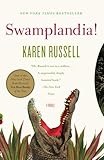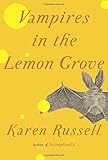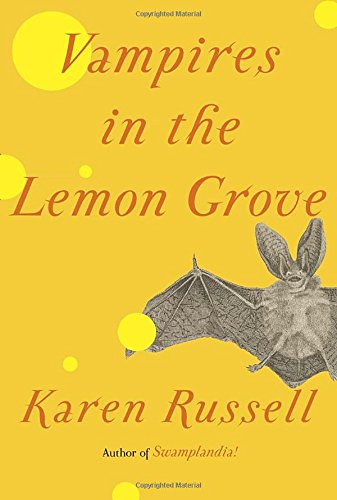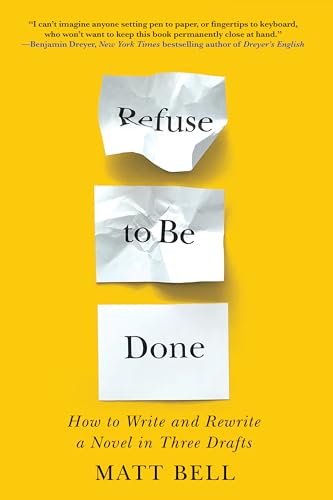
 Karen Russell’s stories defy definition. They are at once warm and sinister, a bubblebath with a shark fin lurking underneath the suds. Hailed as a rising star in the next generation of great writers, Russell has made her name with fiction that expands the possible, gorgeous prose forged in the fires of dark beauty and wistful longing. Her debut collection, St. Lucy’s Home for Girls Raised By Wolves, was set largely in the brackish backlands of Florida, which also served as the backdrop for her novel Swamplandia!, a finalist for the 2012 Pulitzer Prize. Her newest work, Vampires in the Lemon Grove, consists of nine stories spread across decades and continents. I spoke with Ms. Russell by phone a few weeks ahead of her collection’s release, intent to learn more about how the fantastical can humanize us, what caused her to take her stories away from the swamp and why Stephen King is better than The Babysitters Club.
Karen Russell’s stories defy definition. They are at once warm and sinister, a bubblebath with a shark fin lurking underneath the suds. Hailed as a rising star in the next generation of great writers, Russell has made her name with fiction that expands the possible, gorgeous prose forged in the fires of dark beauty and wistful longing. Her debut collection, St. Lucy’s Home for Girls Raised By Wolves, was set largely in the brackish backlands of Florida, which also served as the backdrop for her novel Swamplandia!, a finalist for the 2012 Pulitzer Prize. Her newest work, Vampires in the Lemon Grove, consists of nine stories spread across decades and continents. I spoke with Ms. Russell by phone a few weeks ahead of her collection’s release, intent to learn more about how the fantastical can humanize us, what caused her to take her stories away from the swamp and why Stephen King is better than The Babysitters Club.
The Millions: Vampires in the Lemon Grove is your first book to be set outside of the swamps of Florida. Was that a conscious choice to set your fiction in a new geography?
 Karen Russell: Thank you for noticing! I think it was a conscious choice. Some of these stories I was writing alongside Swamplandia! — I think about half of the collection was written while I was drafting that novel, and then half after that book had come out. My first story collection has a couple of sojourns abroad but most of them have a uniformity of setting. I love the setting of the swamp so much. It feels so familiar. It’s all so humbling, because you see where your preoccupations start to surface. I love that after a novel, where you’re so committed to one place — I spent most my 20s in that goddamn swamp — so it was freeing to get to time-travel a little bit and try on some different skins.
Karen Russell: Thank you for noticing! I think it was a conscious choice. Some of these stories I was writing alongside Swamplandia! — I think about half of the collection was written while I was drafting that novel, and then half after that book had come out. My first story collection has a couple of sojourns abroad but most of them have a uniformity of setting. I love the setting of the swamp so much. It feels so familiar. It’s all so humbling, because you see where your preoccupations start to surface. I love that after a novel, where you’re so committed to one place — I spent most my 20s in that goddamn swamp — so it was freeing to get to time-travel a little bit and try on some different skins.
TM: Many of the stories in your new collection seem to focus on a symbol, like a precious glass window or a treacherous stop screw or a red trip wire. Do you often start writing by building around an image or do they take center stage more organically?
KR: I think it can be both. It’s always exciting when something presents itself as a symbol that you can recognize, something that concretely manifests itself. With the window, I think I was on the L train, and this couple happened to tell me about this settlement where they swapped a window around. They only had one glass window and it was this really rare commodity. That was like a gift from the universe. With the wire, I had this idea of a tattoo, and trying to define whatever desire makes you want to get a tattoo, to memorialize something, and having that unstablize and get really slippery. That took a little while. Same with the stop screw. It was something the story needed. I remember having a conversation with my brother. I was like, “what could you find in a nest? Something really small, like lynch-pin size that if it was knocked lose from your life, it would cause your life to go slack.” And he said, “a condom?” He also suggested Three 6 Mafia’s Oscar. I’m so glad that at some point, the story within a story presented itself, because it would’ve been a different meditation on loss if it was about Three Six Mafia’s Oscar.
TM: I’m pretty sure everyone would’ve been psyched for that story.
KR: I might’ve made a mistake. I might’ve made the wrong call there.
TM: Going back to the red trip wire. With the complex imagery of Sgt. Zeiger’s back tattoo in your story “The New Veterans,” did you find it necessary to create a visual representation for you to write from?
 KR: That’s always my dream. I’d really like to illustrate these stories. You know Reif Larsen had that book come out [The Selected Works of T.S. Spivet] that was so gorgeously illustrated. I remember just touching it with longing. I’ll try to do some doodles, but thank god for words. Otherwise I’d never get the pictures in my mind excised in any form that another could see, because it definitely wouldn’t happen with visual art. I can draw a dog that looks at a clock. I had my own mental template of what that thing looks like. It’s hard to describe a tattoo, it turns out. You feel wasteful. I wish that I could illustrate actually. Maybe somebody will. It’s a pretty ridiculously intricate tattoo.
KR: That’s always my dream. I’d really like to illustrate these stories. You know Reif Larsen had that book come out [The Selected Works of T.S. Spivet] that was so gorgeously illustrated. I remember just touching it with longing. I’ll try to do some doodles, but thank god for words. Otherwise I’d never get the pictures in my mind excised in any form that another could see, because it definitely wouldn’t happen with visual art. I can draw a dog that looks at a clock. I had my own mental template of what that thing looks like. It’s hard to describe a tattoo, it turns out. You feel wasteful. I wish that I could illustrate actually. Maybe somebody will. It’s a pretty ridiculously intricate tattoo.
TM: Your work, along with the stories of writers like Kelly Link and Etgar Keret, is often set in a kind of hyper-reality, where a surreal element is introduced into what we consider to be the normal world. What do you think this rising trend of fantastical elements being incorporated into modern literature signifies about readers’ interests?
KR: It’s funny, because I often think if you look at Kafka, or an entire tribe of Latin American writers, I don’t know how new it is necessarily. I think the conversation about genre in the mainstream feels more fresh and new. I remember in graduate school that many people seemed to be moving away from a really gritty kind of realism. For me, there’s something playful about it. It feels intuitively right to me as a register to try to represent something true in. For people like [George] Saunders and Link, I don’t think any of them would say they were writing about a world that’s not the normal, ordinary world. Often they’re just dilating some aspect of it so you can see, so you can think through it. What’s attractive to me about those stories is in a way they feel so much more honest and so much closer to the real deep and uncanny experience of being alive. They now have this emotional vocabulary to talk about how really freaking weird it is to live any average Tuesday. In addition, it’s exciting to be the arbiter of a whole world. Even a writer like Junot Díaz, who often doesn’t get the rap of being a fabulist or using magical realism, his stuff is him reading Dominican history through the lens of Tolkein and Frank Herbert. That’s another way people are filtering history. I just think those distinctions sometimes feel rigid and false to me.
TM: There are three stories in Vampires in the Lemon Grove that share the common traits of featuring a young male protagonist in the midst of dark circumstances. Why do you think adolescent boys and scary stories fit so well together?
KR: I love scary stories. I really loved them when I was younger and I still love them now. I love the experience of being afraid. What it did for me when I was a kid is give me a way to contend with all kinds of unruly appetites like violence, discomforting tragedy, and questions that couldn’t be addressed in speech. From an early age, I always preferred to read a Stephen King book to something like the Babysitters Club. In the funhouse mirror of those books, you could see so much of what’s unspeakable about life on this planet represented. Between the covers was like a safe place to contend with monstrosities. In the last story of Vampires [“The Buried Doll of Eric Munis”], I think he’s an adult consciousness retrospectively looking back at the monster that he used to be. It’s a horror story about contending with your own youthful indiscretions and the afterlife that has. As a writer, it’s helpful to put on a boy voice because it gets me a little farther away from myself. It gives me a nice leap to try and take. I think there is something fascinating about the wickedness that boys get up to in groups. I used to take these groups of high school students abroad, and I swear to god, the boys individually would be beyond sweet, but collectively they would transform and posses this evil energy. I don’t know what unleashed that genie but you’d have this sweet kid who looked like a hot dog, a skinny little sweetheart who wrote poems, and then you’d plug him into a group of nine boys and it was terrifying.
TM: Your title story follows two aging vampires who’ve settled down in an Italian lemon grove. Did this story generate from a desire to put your own spin on the emerging deluge of vampire literature?
KR: I feel some embarrassment at the title of this collection, because even though it felt kind of right, metaphorically, to apply the title to all of the characters in this collection — everybody’s kind of a monster, everybody’s dealing with an illicit appetite — I didn’t know the Stephanie Meyer thing was going to happen. It’s a sad thing to feel a little bit like a biter of Stephanie Meyer. Nobody wants that in this life. I loved Dracula when I was kid. That was my favorite monster. Vampires are just rich as characters, in terms of hunger and addiction and unregulated appetite. They’re pretty great. We really did something right by creating a monster that resembles humans with an unquenchable thirst. It’s fun for me to play with those strong conventions. People already have a relationship to vampires that’s so deep, and I guess in this case, something about it just felt right. I like the idea that what keeps you trapped in your most monstrous version of yourself is this belief that you are a monster.
TM: And yet Clyde is really humanized when we learn in the story that drinking blood isn’t a vital component of a vampire’s survival.
KR: I feel like we all know vampires, so you can relate to Clyde’s befuddlement when he learns that this dysfunctional and evil thing he’s been doing isn’t necessary or effective. It’s like, ok, now what?
TM: It reinforces this idea that he’s wasting his own immortality trying to figure what he’s supposed to be doing.
KR: Yes! It’s all one long Sunday, right?
TM: Exactly. There’s a similar vibe going on in “The Barn at the End of Our Term,” where an assortment of U.S. Presidents have been possibly reincarnated as horses.

 KR: That story is maybe the strangest leap in there in some ways. I was living with my best friend, Carrie, who had horses, and she had this book by Mary Twelveponies called There Are No Problem Horses, Only Problem Riders. I thought that book was amazing. I read that, and I’d just read Kevin Brockmeier’s The Brief History of the Dead, and I was taken with some of the questions his book raises, this whole idea that when people die, they go to this liminal space where nothing is resolved and they’re just as clueless as when they were alive. There’s something sweet and naïve on our part to think that all of our questions will be answered when we die, that we’ll get one final answer to everything. And also I think I watched this really long documentary about the U.S. Presidents while I had the flu. I wish I could connect it to our current election cycle, because then I would sound topical and smart, but actually it’s one of the older stories in the collection. So I had these ideas percolating: Brockmeier’s meditations on the afterlife and the hagiography of these powerful men. It was sort of this ode to ambition. Originally, it was going to be each of the presidents being reborn into a different situation, and the first one I came up with was for Rutherford B. Hayes to be stabled in his afterlife. This is turning into the forensics of my own bad idea now.
KR: That story is maybe the strangest leap in there in some ways. I was living with my best friend, Carrie, who had horses, and she had this book by Mary Twelveponies called There Are No Problem Horses, Only Problem Riders. I thought that book was amazing. I read that, and I’d just read Kevin Brockmeier’s The Brief History of the Dead, and I was taken with some of the questions his book raises, this whole idea that when people die, they go to this liminal space where nothing is resolved and they’re just as clueless as when they were alive. There’s something sweet and naïve on our part to think that all of our questions will be answered when we die, that we’ll get one final answer to everything. And also I think I watched this really long documentary about the U.S. Presidents while I had the flu. I wish I could connect it to our current election cycle, because then I would sound topical and smart, but actually it’s one of the older stories in the collection. So I had these ideas percolating: Brockmeier’s meditations on the afterlife and the hagiography of these powerful men. It was sort of this ode to ambition. Originally, it was going to be each of the presidents being reborn into a different situation, and the first one I came up with was for Rutherford B. Hayes to be stabled in his afterlife. This is turning into the forensics of my own bad idea now.
TM: When you’re writing about the presidents, or in “The New Veterans” where you talk about IEDs and Fadaliyah, Iraq, how obligated do you feel to root your fiction in facts?
KR: I think with the president’s story, it’s a lot looser in a lot of ways. That one maybe felt a little lighter to me, although I also felt deeply sad for this man who believes in a really standard heaven but then finds himself in an extraordinary circumstance. It’s not like it was a bad Saturday Night Live sketch that I had no emotional connection to. With “The New Veterans,” that felt like the riskiest one to me, because it’s contemporary and such a sensitive topic. There are a lot of veterans that I’m close too, and so much of the heart of that story is pretty personal. That was the one I probably put the most work into. There’s a lot of delivery ambiguity, a lot of fogginess inside that story. Nothing is specifically true, but I read quite a bit in preparation for it to be as plausible as I could make it. In order for the more fantastical elements to hold any emotional resonance, I felt like I had to get all the historical stuff correct. I was a lot more conscious and anxious about that one then the “The Barn at the End of Our Term” because I didn’t think Dwight Eisenhower’s relatives were going to be too upset with me.
TM: I found that the concept of time seems to permeate many of your stories, whether it is omens from the future, changes to the past, or uncertainty over the present. Was time a specific focus in this collection?
KR: I feel like I wake up to that stuff halfway through sometimes. You figure out what you’re up to, and then you can consciously make those connections. I decided it’s like blood rising to a cut. There might be something you compulsively want to address or think through, and then when you figure out what it is you can consciously shape it a little bit, but I don’t think I always have so much control over what the heart of a novel or story is. I think at a certain point I realized how many of these stories had to do with hunger and how to deal with certain appetites. A lot of these stories are also about stories, in a somewhat goofy, probably too explicit way. There’s a lot of traumatic repetition, and trying to figure how to tell a new story to move past it. With the writers I love, you see the same things surging up again and again. Maybe we all get like a finite set of preoccupations, but you just have to find new ways to let them give life to your stories.












